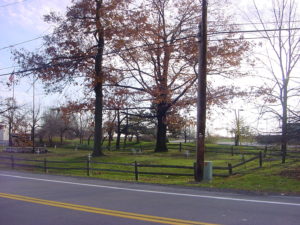The cars speeding down Aero Drive in Cheektowaga did not pay me nor my destination any heed. I took the first photograph and then wandered across the busy road. I had come to pay my respects to Nathanial Thayer, a fellow New Yorker. He was a man who did something for me that I cannot repay. I never knew him, nor ever would. He may have stood about five feet six inches tall, with brown hair and blue-grey eyes. In his early to mid twenties he met his fate and was buried in a cemetery that did not yet exist.
Who was Nathanial Thayer you may ask? His is a story much like that of the hundreds of others buried here in a forgotten cemetery for those who died during the War of 1812. Sources tell us that the statistics above were for the average male of that day. What we do know of Nathanial Taylor was that he was in the 23rd Regiment of Infantry from New York and that he died on August 23, 1814. His cause of death was most likely not from the wounds of battle, but from the terrible diseases that claimed many lives: diarrhea, dysentery, and typhus.
During the winter months of 1812, after an unsuccessful attempt to invade Canada, General Alexander Smyth established and built barracks in the small village of Williams Mills (now Williamsville). As the war progressed and the concentration of troops in the Niagara region increased, so did the size of the encampment. The year 1814, saw the nearby Battles of Chippewa and Lundy’s Lane and the creation of the medical hospital where the barracks had existed. This site was only a short distance away from where the cemetery now lies. The records of the head surgeon of the hospital, Dr. Joseph Lovell, paint a grim picture. He tells us of the abnormally warm and rainy weather that would lead to the onset of severe dysentery and typhus. “Patients were not sent to the general hospital until at least the third week of the disease after being treated by various methods, depending on the surgeon in charge.” It has been determined that the date the hospital was created was July 29, 1814. Sadly, if we add a mere three weeks to this picture, we can speculate that Nathanial most likely died from one of the aforementioned diseases.
This cemetery holds the bodies of Nathanial Thayer and 200 more American and British soldiers that died between the years 1814 and 1815.
This cemetery holds the bodies of Nathanial Thayer and 200 more American and British soldiers that died between the years 1814 and 1815. Most were buried in trench graves and likely not very deep. These forgotten men of a war none of us think of were wrapped in sheets and laid to rest somewhere that may have been far from home with no marker to even tell their story or someone to pray over them. There is a stand of ten Sugar Maple trees nearby that it is said may have been planted by the fallen soldier’s fellow men at arms to silently stand watch over their resting place
For over 80 years they would be forgotten until 1898 when the cemetery was deeded to the Buffalo Historical Society. From this day forward the cemetery would receive the attention it deserves, beginning with the construction of the wrought iron sign marker in that year. As the century turned the cemetery would acquire some of the items, seen their today, including an impressive cannon captured by the British during the War of 1812 and returned to the Buffalo Historical Society in 1936 where it was placed on the platform along with both the flags of the United States and Great Britain to honor their respective fallen soldiers. Improvements to the cemetery continued, culminating in its addition to the National Register of Historic Places in 2002.
Buffalo is a city of great and varied history. A small roadside sign off busy Transit Road led me to this hidden gem.
Buffalo is a city of great and varied history. A small roadside sign off busy Transit Road led me to this hidden gem. The flag that I placed on Nathanial’s grave is a silent testament of remembrance to a man that I never knew but helped keep this country free when Great Britain sought to change what our Founding Fathers had fought and died for some 40 years prior. On this Memorial Day, when we remember fallen soldiers and listen to the sounds of Taps being played, I ask that you not forget about these 200 souls that lie off Aero Drive, in the shadow of the airport. Visit them, find the shady trees that they repose beneath, and thank them for being freedom fighters and heroes.
Lead image: Shinerunner on Wikipedia
The post The War of 1812 Cemetery appeared first on Buffalo Rising.

